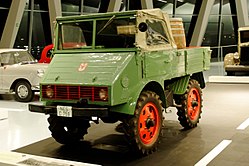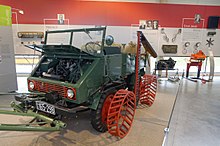Unimog 70200
| Unimog | |
|---|---|
|
Unimog 70200 in the Mercedes-Benz Museum
|
|
| Unimog 70200 | |
| Manufacturer: | Boehringer |
| Sales designation: | Unimog |
| Production period: | 06.1948-04.1951 |
| Previous model: | none |
| Successor: | Unimog 2010 |
| Technical specifications | |
| Engines: |
OM 636 (diesel, 1697 cm³) |
| Power: | 18.5 kW |
The Unimog 70200 is the first series-produced vehicle in the Unimog series, manufactured by Boehringer . Between June 1948 and April 1951 exactly 600 vehicles were manufactured in Göppingen before production was sold to Daimler-Benz . Daimler-Benz continued to build the vehicle almost unchanged as the Unimog 2010 . 100 to 120 Unimog 70200 should be preserved.
The designation “70200” indicates the Boehringer cost center ; The chassis numbers of the vehicles also began with 70200. Individual equipment variants of the vehicles were marked with lowercase letters.
development

The Unimog goes back to a development by the designer Albert Friedrich , who developed aircraft engines as an engineer at Daimler-Benz during the Second World War. After the war, Friedrich planned to build an agricultural vehicle. The vehicle should resemble a two-axle tractor , but have all-wheel drive and good off-road capabilities. In addition, a loading area, a protected driver's cab, a towing device at the rear of the vehicle and the possibility of attaching attachments and driving them with a PTO shaft were provided. The engine should deliver 25 HP (18.5 kW), so that the top speed would be 50 km / h.
The first plans were made in 1945. In November 1945, Friedrich received a production order , permission from the US military administration to develop the vehicle and build ten test vehicles. This confirmed that the vehicle would have no military purpose. On December 1, 1945, Friedrich signed a contract for the production of the vehicles with the gold and silver goods factory Erhard & Sons from Schwäbisch Gmünd . Initially, two engineers worked on the project. In January 1946, Heinrich Rößler , who had previously worked at Daimler-Benz, joined as the third engineer . Rößler later became head of the Unimog department at Daimler-Benz. He played a key role in the development of the Unimog for series production.
After the first drafts, the second overall draft was completed in March 1946. Much emphasis was placed on the functionality of the construction. The track width was set at 1270 mm, which corresponds to two rows of potatoes. Only four drive joints were provided for the chassis, the banjo axles called “sheet metal axles” were planned to be identical at the front and rear, as were the impeller countershafts. In addition to the initial considerations, the vehicle should have differential locks on both axles as well as coil suspension with shock absorbers.
The first prototypes were made by Erhard & Söhne in 1946. They received the M 136 gasoline engine . Numbers 1 to 4 no longer exist; they were either scrapped or lost. According to Daimler, the first test drive with prototype 1 was carried out on October 9, 1946. The vehicles were presented to specialists as early as autumn 1946. The engineer Hans Zabel noted on a drawing the name "Universal-Motor-Gerät", which was drawn together to the acronym "Unimog". The vehicle was officially named on November 20, 1946. Later prototypes were assembled at Boehringer in Göppingen and were fitted with a diesel engine. The U 5 prototype is now in the Agricultural Museum of the University of Hohenheim, the U 6 prototype in the Unimog Museum in Gaggenau .
Irrespective of the Unimog development, Daimler-Benz had been working on a successor engine for the OM 138 since the days of the Second World War , with which the new Mercedes 170 passenger car was to be equipped. The engine called Mercedes-Benz OM 636 was ready for series production in 1948. The Unimog designers decided in 1947 that the series vehicles should be equipped with a diesel engine; the choice fell on the engine being developed by Daimler-Benz AG. This explains why the OM 636 was already installed in the Unimog before its series launch in 1949. Comprehensive tests and a presentation of the vehicle to a broader public took place as early as 1947. In order to be able to start series production of the Unimog, larger production capacities were required, so Boehringer was commissioned with production in Göppingen. This enabled Boehringer to avoid being dismantled by the Allies. From then on Erhard & Söhne worked as a parts supplier for Boehringer. In June 1948, the pre-series production finally started. The vehicle was presented to the public at the Mercedes-Benz stand at the DLG exhibition in Frankfurt in August 1948 and has already been pre-ordered 150 times there. On November 21, 1948 a patent for the Unimog was registered for the first time under the number 950 430; the main focus was on the portal axes . Series production officially started in February 1949.
Series production and sale to Daimler-Benz
Boehringer did not use an assembly line, so the Unimog was largely handcrafted. From 1949, 90 additional employees worked on the Unimog in addition to the original developers. A sales network and customer service were established. Around fifty vehicles were built per month. The demand for the Unimog rose sharply because it was in demand in many areas. It quickly became apparent that Boehringer could no longer meet demand. In October 1950, Boehringer sold the Unimog production to Daimler-Benz. Production in Göppingen ran out by April 1951, before moving to Gaggenau. Many suppliers and employees then also switched to Daimler-Benz. From June 1951, the Unimog rolled off the assembly line at Daimler-Benz as the Unimog 2010 . Erhard & Söhne remained a supplier for the Unimo axles until 1963.
technical description
The Unimog 70200 is a compact, approximately 3.5 meter long vehicle with a U-profile ladder frame , rigid portal axles with bolted axle covers at the front and rear, and four wheels of the same size that are driven by means of a rear wheel drive. The front and rear axles are guided on drawbars and panhard bars . They have coil springs with hydraulic shock absorbers . The tires of the Unimog are all-purpose tires of size 6.5-18, which are designed for off-road and road driving. The vehicle has a hydraulically operated brake system that acts on the brake drums on all wheels.
The engine is originally a car engine, but it was tested in the Unimog before it was installed in a car. It is the OM 636 912 , a Reihenvierzylinder- prechamber -Saugdieselmotor with lateral camshaft and 1697 cc, the 25 hp (18.5 kW) at 2300 min -1 guaranteed. The water-cooled motor is installed in the center of the front and tilted slightly backwards. It is started with an electric starter. What is striking about this engine is that, unlike the following models of the same type, it has a split valve cover.
A non- synchronized all-claw transmission with six forward and two reverse gears was installed as the transmission . It has a speed range from 1 to 50 km / h. The rear axle is permanently driven, the front axle drive can be switched on and off while driving without using the clutch.
Technical specifications
| model | Unimog 70200 |
|---|---|
| engine | OM 636.912 |
| design type | Water-cooled in-line four-cylinder pre-chamber diesel engine |
| Displacement | 1697 cc |
| rated capacity | 25 hp (18.5 kW) at 2300 min -1 |
| coupling | Single-disc dry clutch |
| transmission | All-claw transmission 6 forward gears, 2 reverse gears, not synchronized |
| Braking system | Hydraulic drum brakes on all four wheels |
| Tires | 6.5-18 |
| Fuel tank volume | 40 l |
| Dimensions | 1775 kg |
| Gauge | 1270 mm |
| wheelbase | 1720 mm |
| Ground clearance | 380 mm |
| length | 3520 mm |
| width | 1630 mm |
| Height (above windshield) | 2020 mm |
| Turning circle diameter | 7600 mm |
literature
- Lutz Nellinger: The Unimog: workhorse and cult mobile. Komet, Cologne 2016, ISBN 978-3-86941-581-9 .
- Carl-Heinz Vogler: Unimog 411: Type history and technology. GeraMond, Munich 2014, ISBN 978-3-86245-605-5 .
- Carl-Heinz Vogler: Unimog type atlas. All Unimog classics from 1946 to 1993. GeraMond, Munich 2015, ISBN 978-3-86245-026-8 .
Individual evidence
- ↑ Vogler, type Atlas Unimog. All Unimog classics from 1946 to 1993. p. 17
- ↑ Mercedes-Benz Public Archive: U 25, model series 70200
- ↑ Nellinger, p. 6
- ↑ a b Nellinger, p. 7
- ↑ a b Vogler, Unimog type atlas. All Unimog classics from 1946 to 1993. p. 6
- ↑ a b c Nellinger, p. 8
- ↑ a b Remszeitung: Erhard & Söhne - a nucleus of the Gmünder industry. May 4, 2015
- ↑ Vogler, type Atlas Unimog. All Unimog classics from 1946 to 1993. p. 13
- ↑ Daimler AG (Ed.): The Unimog turns 70: First test drive with the Unimog prototype on October 9, 1946 , published on October 7, 2016. Accessed on January 15, 2018
- ↑ Nellinger, p. 9.
- ↑ a b c Vogler, Unimog 411: Type history and technology. Pp. 48 and 49
- ↑ Nellinger, p. 10
- ↑ Nellinger, p. 11
- ↑ a b c Legends of Trucking: Boehringer Unimog (series 70200)
- ↑ Daimler AG: Unimog patent pending
- ↑ a b Nellinger, p. 12
- ↑ Nellinger, p. 14.
- ↑ Nellinger, p. 15
- ↑ Vogler, p. 92.
- ↑ Carl-Heinz Vogler: The Unimog type book: the complete model history . GeraMond, Munich, 2009. ISBN 978-3765476990 . P. 17
- ↑ a b c d Boehringer: Historical prospectus Unimog
Remarks
- ↑ All the chassis of the Unimog 70200 with 6.5–18 ″ tires can be seen in contemporary images from Daimler-Benz AG, cf. here.

